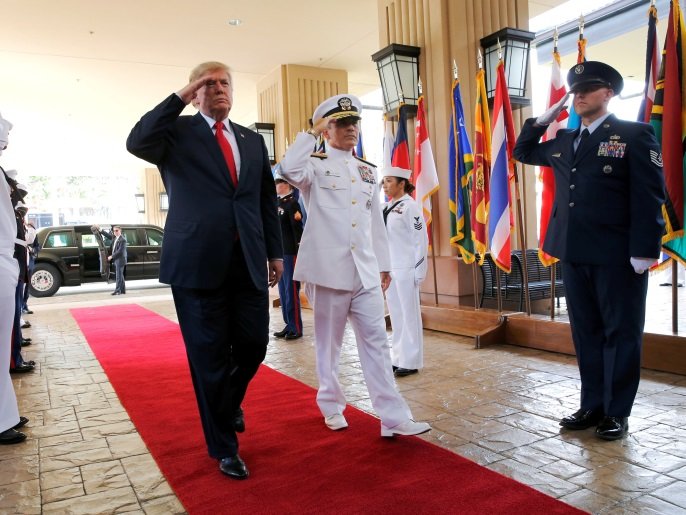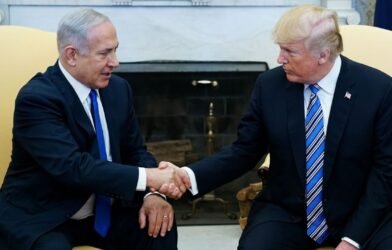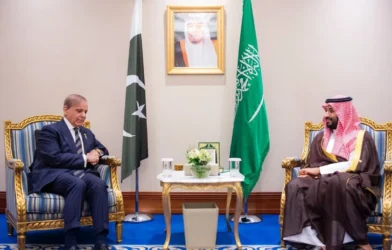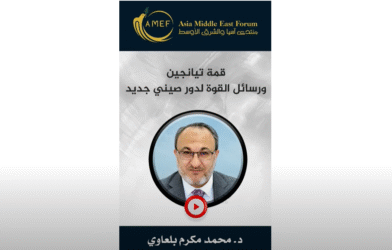Subtotal $0.00
Burying Myrath and Obama
Complex Asian files
Change or stagnation
The U.S. President's Donald Trump In Asia, the longest tour by a U.S. president since the George H.W. BushThe 11-day trip will take him to five Asian countries, including Japan and South Korea and China and Vietnam and the Philippines.
Trump's advisers summarize the goals of his Asian tour in three objectives: Countering the North Korean nuclear threat, standing up to China's maritime encroachment, and renegotiating trade agreements with Asian partners.
Burying Myrath and Obama
One of the first things Trump did when he took office was to cancel the Trans-Pacific Partnership (TTP) trade agreement passed under former President Barack ObamaIt has been offering trade facilities to East Asian countries with the aim of fortifying the region against China's ever-expanding influence.
This cancellation has made most Asian countries feel anxious and insecure, as Trump's retreatist policy announced at the beginning of his presidency, his direct assertion that others should not be dependent on his country in the field of security, and that US military power will be at the service of those who pay; is about to upend the equation established after the World War IIupside down.
| “ We can say that India is the present absentee in Trump's Asian tour, as the US strategy - during the past two decades - has been based on considering China as the first strategic threat to Washington, and working to hinder its economic and strategic rise by isolating it and draining it in conflicts with its neighbors. Among the most important countries that America relies on in this field are India “ |
The abandonment of the TTIP Pacific Oceanand Obama's plan to deal with the Chinese threat, called the "Asia Pivot," calls for the formulation of a new alternative strategy in Asia, and this is what the tour promises, during which Trump is expected to present his own vision of the American role in the continent and draw the lines of the future in this regard.
It is understood that the plan will focus on free trade between India This raises an important question about India's role in this tour, even if it is not among the countries it is targeting.
We can say that India is the present absentee in Trump's Asian tour, as the US strategy - during the past two decades - has been based on considering China as the first strategic threat to Washington, and working to hinder its economic and strategic rise by isolating it and exhausting it in conflicts with its neighbors.
One of the most important countries that America is counting on in this area is India. George W. Bush U.S. cooperation with Pakistan in favor of further improving the relationship with India, and took New Delhi Improved relations with the Western camp and Israel steadily, especially with the Narendra Modi The country's governing body.
After his visit to Hawaii, Trump will be the guest of the Japanese prime minister on Nov. 5 Shinzo AbeHe is expected to discuss commitment to Japan's security and the threat of North Korea which has been launching ballistic missiles through Japan's airspace in a provocative and insulting manner, and supporting Japan in its conflict with China over the East China Sea, especially the Senkaku Islands.
The renegotiation of trade with Japan following America's withdrawal from the Trans-Pacific Partnership and the attempt to modify the Trans-Pacific Partnership will also receive attention. Trade balance heavily tilted in the Japanese direction, by 68.9 billion dollar.
Complex Asian files
As for South Korea, which Trump will visit for two days on Nov. 7, it seems that his task will not be as easy, as the current president of Korea Moon Jae-in -He is left-leaning and does not want war or escalation with North Korea.
He even tried before to talk to the northern neighbor without going through the U.S. gate to avoid a potential war, of which the capital would be the first casualty Solnot far from the demilitarized zone in the north.
| “ Perhaps the most important event on his long trip, the US president is expected to address the Asia-Pacific Economic Cooperation (APEC) Regional Economic Summit in Da Nang, Vietnam, on Friday (November 10). At the summit, Trump is expected to announce the U.S. strategy for Asia “ |
Although he had previously approved the U.S. missile system agreementThad"He refused to let his Chinese neighbor, who saw it as a direct threat to both his national security and his electoral base, take the initiative. United States for military escalation with the North.
However, in light of the US president's desire for small victories, we may see arms sales deals signed between the two countries, and the issue of trade relations may see new developments, especially in the negotiation of the KORUS trade agreement.
After South Korea, President Trump will make a two-day visit to China on Thursday, during which he is expected to capitalize on his good relationship with President Xi Jinping to make some trade gains.
As for the issue of North Korea, it does not seem that Trump will make a major breakthrough, although he will ask China to stop the flow of energy to North Korea, stop trade cooperation and banking transactions with North Korea, prevent the smuggling of goods across the border between the two countries, and not allow North Korean workers to work in China, which means cutting off the main lifeline of the "troublesome neighbor."
It is true that Beijing It has cooperated with the U.S. in pressuring North Korea twice in the past. Security CouncilThe collapse of the regime in Korea has potentially catastrophic consequences for China, not the least of which is the influx of millions of Refugees Koreans on China, which would be a disaster for China's development and economy.
It is likely that Trump will try to convince his Chinese counterpart to open local markets to American industries and sign trade agreements that he can present as an achievement of his visit, and it seems that China understands this well and therefore does not mind facilitating in this matter, without harming its strategic interests.
Perhaps the most important event of the U.S. president's long trip is his speech on Friday (Nov. 10) at the Asia-Pacific Economic Cooperation (APEC) Regional Economic Summit in Danang, Vietnam.
At this summit, Trump is expected to announce the US strategy for Asia, which will be based on making the Indo-Pacific region an open trade zone and is seen as a response to the giant Chinese project known as the Belt and Road Initiative (BRI).
Change or stagnation
Following the conference, Trump will travel from the conference venue to Hanoi to meet with President Tran Dai Quang to discuss a range of important topics, most notably Vietnamese anger over the departure of Washington from the Trans-Pacific Partnership, of which Vietnam has been the biggest beneficiary.
Trump will also try to tilt the trade balance in Vietnam's favor and discuss Conflict Vietnam and China in the South China Sea, but the atmosphere of the discussion will be dominated by economic issues.
| “ There is no doubt that this Asian tour will be a test for the current US administration, which showered the previous Obama administration with numerous criticisms, which focused on its inability to address Chinese expansionism, the growth of the North Korean threat, and the conclusion of trade agreements that the Trump administration usually describes as "unfair." However, many American experts are concerned about Trump's personal performance and his unruly personality. But many U.S. experts are wary of Trump's personal performance with his outgoing personality “ |
Trump's visit to the Philippines on Sunday (Nov. 12) will be no less important than previous visits, due to the importance of Trump's meetings with Asian leaders, and his Filipino host Rodrigo Duterte He will be more comfortable with him than his predecessor Obama, due to the similarities between the two Populist And a whimper.
This could be an opportunity for a closer relationship between Manila The two presidents are believed to discuss North Korea and U.S. support for the Philippines in the fight against Al-Qaeda organization.
Trump's presence there will also coincide with multiple meetings of the Association of Southeast Asian Nations (ASEAN), and a statement affirming freedom of navigation in strategic sea lanes is likely, although things may not be easy due to the presence of countries on good terms with China (such as Myanmar, Laos and Cambodia), all of which have veto power that could derail any of the organization's decisions.
There is no doubt that this Asian tour will be a test for the current US administration, which showered the previous Obama administration with numerous criticisms, which focused on its inability to address Chinese expansionism, the growth of the North Korean threat, and the conclusion of trade agreements that the Trump administration usually describes as "unfair."
It seems that many American experts are concerned about the personal performance of Trump, with his loose-tongued personality and populist rhetoric, who is visiting a region that values protocol and formalities; will he succeed in capitalizing on the personal relationships he has already built with heads of state? Or will the trip turn into a series of ridiculous situations and destroy the desired media achievement?
In terms of North Korea's growing power, attempts by the United States to control Korea in the 1950s led to the Korean War, which divided the country into two parts: the southern part, the largest and most loyal to Washington, and the northern part, which signed a joint defense treaty with China in 1962: The southern part, which is the largest and loyal to Washington, and the northern part, which signed a mutual defense treaty with China in 1962.
After decades of different US strategies and attempts to pressure North Korea's main ally China, the US side has not been able to subdue the North Koreans, instead pushing them further into militarization.
Will the US side finally realize that the best way to deal with North Korea is to contain it and deal with it as a nuclear reality, which means dragging it to the dialogue table and giving it larger regional roles and major economic opportunities that will bring it out of its isolation and fear, and encourage it to gradually open up to the world and integrate into the international community and enter the game of interests and gains.









